
Mark Reed, DPM 714-528-FOOT
1275 Rose Drive Placentia, CA Suite 136
Melanie Reed, DPM 714-528-7777
1275 Rose Drive Placentia, Ca Suite 124
Podiatrists @ Placentia-Linda Foot & Ankle Group
BOTTOM OF THE HEEL PAIN
PLANTAR FASCIITIS, CALCANEAL BURSITIS, SEVER'S DISEASE, SCIATICA REFERRED PAIN AND TARSAL TUNNEL SYNDROME
When foot pain and tenderness occurs in the bottom of the heel, most commonly the podiatry problem is related to an inflammation of the Plantar Fascia. This discussion will focus on pain to the bottom of the heel and not to the ankle joint or the rear of the heel.
Besides plantar fasciitis, there are a few other conditions that need to be considered in diagnosing heel pain. These conditions include ruling out the presence of a calcaneal stress fracture, an entrapment of the nerve going to the inside or outside of the heel, radiating pain from sciatica from the hip or back and / or an nerve compression in the ankle called tarsal tunnel syndrome. In teenagers, there is also a common condition with the growth plate causing bottom of the heel pain called Sever's Disease.
PLANTAR FASCIITIS AND HEEL SPUR SYNDROME
The Plantar
Fascia is a strong inelastic band of fibers which begins at the
heel and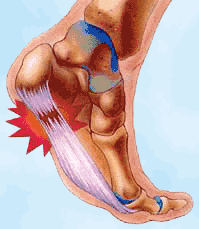 extend
into the toes. When the Plantar Fascia becomes inflamed,
the pain is mainly in the arch of the foot. Medically,
this condition is called Plantar Fasciitis. When the Plantar
fascia becomes inflamed and the pain is mainly in the heel, medically
this condition is called Heel Spur Syndrome. The usual
cause of Plantar Fasciitis or Heel Spur Syndrome is excessive
pulling on the Plantar Fascia from either excessive exercise,
poor fitting shoe gear or poor foot alignment while running or
standing.
extend
into the toes. When the Plantar Fascia becomes inflamed,
the pain is mainly in the arch of the foot. Medically,
this condition is called Plantar Fasciitis. When the Plantar
fascia becomes inflamed and the pain is mainly in the heel, medically
this condition is called Heel Spur Syndrome. The usual
cause of Plantar Fasciitis or Heel Spur Syndrome is excessive
pulling on the Plantar Fascia from either excessive exercise,
poor fitting shoe gear or poor foot alignment while running or
standing.
Plantar fascia pain usually begins as a mild pain to either the arch area or the bottom of the heel. The discomfort in the foot is usually most noticeable with the first step in the morning and seems to improve after a period of "warming up" the foot. If untreated, the pain can become intolerable. In some individuals, actual heel spur formation can occur at the site of where the Plantar Fascia is connected to the heel. The heel spur is actually a ridge of bone that forms to reinforce where the plantar fascia attaches to the heel. The ridge of bone is not the main problem unless a small nerve under the plantar fascia becomes entrapped. The Plantar Fascia is the primary pathological anatomical structure that is causing pain to the patient. If the pulling on the plantar fascia is corrected, it is important to understand that the heel spur that formed from the pulling is not important and does not need to be removed with surgery. There are many doctors who get the heel spur confused and tell the patient that a heel spur is causing their pain when in fact it is the injury to the Plantar Fascia that needs to be medically treated.
Home care for either Plantar Fasciitis or Heel Spur Syndrome primarily consists of resting the foot, applying ice to the affected area three times a day for ten minutes, and using a supportive athletic shoe for most activities during the day. Sometimes stretching the arch by rolling the foot on an empty soft drink bottle in the morning helps relieve some of the pain. In addition, using a heel pad or a padded insole can be helpful in relieving the pain in the heel. If these home treatments do not relieve the pain, treatment by a foot and ankle specialist is warranted.
In treating heel and
arch related foot pain, an X-ray of the foot is usually obtained
to rule out a rare heel stress fracture and to document if a
heel spur has occurred. Once a diagnosis is made of either Heel
Spur Syndrome or Plantar Fasciitis, initial treatment usually
consists of anti-inflammatory medications, the use of a night
splint and functional foot orthotics. A night splint is required
to hold the foot in the correct position during sleep to allow
the Plantar Fascia to heal in the correct length as when standing
and walking. A functional orthotic is required to control the
amount of pulling that is occurring in the Plantar Fascia with
weight bearing by controlling the position of the foot in the
shoe. In some cases a cortisone shot is placed into the area
of the origin of the Plantar Fascia to rapidly reduce the amount
of pain that is present. However, in many cases, a cortisone
shot results in only a couple of weeks of pain relief and the
problem is back with the same intensity of pain or even worse
than before the cortisone shot.
Surgical intervention of either Heel Spur Syndrome or Plantar
Fasciitis is rarely indicated and should be considered only after
use of the night splint and / or the functional foot orthotic
has failed. The surgery is warranted if the Plantar Fascia band
has become too short due to repeated injury to where the Plantar
Fascia or the nerve under the Plantar Fascia has become entrapped.
An experienced surgeon should only performed this type of surgery.
The primary purpose of the operation is to lengthen the Plantar
Fascia and remove the excessive bone formation where the Plantar
Fascia is anchored to the heel bone. In many surgical cases,
there is also an adventitious bursa that must be excised. Over
the last five years, a procedure has been advertised for heel
spur surgery using a scope with claims to have a better recovery
time and less associated pain compared to traditional procedures.
However, to date this procedure has not demonstrated any better
advancement over traditional methods and has actually been associated
with a higher rate of complications than traditional procedures.
Because Heel Spur Syndrome
and Plantar Fasciitis is an inflammatory condition, early intervention
is essential to stop the repeated scarring of the Plantar Fascia
that can lead to irreversible shortening of the Plantar Fascia,
nerve entrapment and the formation of a painful adventitious
bursa.
CALCANEAL BURSA AND CORTISONE INJECTIONS
A calcaneal adventitious bursa
is an enlargement of inflammatory tissue under the heel bone
that feels like a nail going into the bone when standing on a
hard surface. This condition is most commonly associated with
long standing plantar fasciitis or heel spur syndrome where swelling
and inflammation leads to the additional problem of the formation
of the calcaneal adventitious bursa. Treatment usually involves
an injection of cortisone directly into the bursa to reduce the
size of the bursa and the associated pain to the heel bone. Because
adventitious bursa formation is associated plantar fasciitis
or heel spur syndrome, there are some patients that will need
a cortisone injection to the bursa but not to the where the plantar
fascia is connected to the heel bone. The concept here is that
the plantar fascia that has been injured causing the plantar
fasciitis or heel spur syndrome must scar in and heel to stop
hurting and if cortisone is placed in this area early in the
healing process, then the plantar fascia will not heal. The heel
will feel better for two to four weeks but when the cortisone
is subsequently absorbed by the body the heel pain will return
because the injury to the plantar fascia was never resolved.
For many patients who have had only cortisone injections treat
their plantar fasciitis or heel spur syndrome and not to treat
an adventitious bursa, the experience has been frustrating with
no resolution to their plantar fasciitis or heel spur syndrome.
SEVER'S DISEASE OR CALCANEAL APOPHYSITIS
Sever's
Disease is a common condition in early teenagers due to the blood
supply 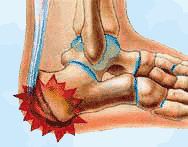 to
the growing plate is not keeping up with the demands of growing.
The pain that occurs is a deep ache or soreness to the
corner of the heel and tends to be aggravated with running activities.
The pain can be debilitating for a youth. Treatment consists
of ultrasound to the heels with message therapy two to three
times a week for two to three weeks, decreasing athletic activities
for two weeks and the use of custom made foot orthotics to help
improve foot biomechanics. Prior to treatment, x-rays should
be obtained to rule out any problem with the growth plates in
the foot and ankle.
to
the growing plate is not keeping up with the demands of growing.
The pain that occurs is a deep ache or soreness to the
corner of the heel and tends to be aggravated with running activities.
The pain can be debilitating for a youth. Treatment consists
of ultrasound to the heels with message therapy two to three
times a week for two to three weeks, decreasing athletic activities
for two weeks and the use of custom made foot orthotics to help
improve foot biomechanics. Prior to treatment, x-rays should
be obtained to rule out any problem with the growth plates in
the foot and ankle.
CALCANEAL STRESS FRACTURE
iuj89Calcaneal stress fractures would present with
a sharp pain to the heel that would increase with weight bearing
but would not be any more painful with the first step in the
morning such as is seen with plantar fasciitis. X-rays
are the standard test that is performed but a CT may be indicated
do to the square shape of the calcaneus. Treatment is non-weight
bearing in a cast for at least 6 to 8 week depending on the severity
of the stress fracture. Early treatment is essential to
prevent a further fracture of the calcaneus.
CALCANEAL NERVE ENTRAPMENT
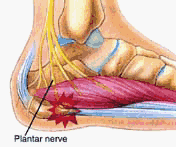 There is a nerve called the Medial Recurrent
Calcaneal Nerve off the Posterior Tibial Nerve from the ankle
that goes under the inside of the heel. This nerve can
become entrapped and cause a burning pain to the underside of
the heel. The pain can mimic plantar fasciitis but does
not increase with the first step in the morning. The symptoms
for this nerve entrapment would include a burning type pain,
tends to be worse at night and has a point of maximal tenderness
where the nerve is entrapped. Diagnosis is made by numbing
the point of maximal tenderness and determining if the pain disappears
while the local anesthetic is working. Treatment would
include removing whatever is pressurizing the nerve such as changing
shoes, trying the use of a pad over the area to reduce the pressure
on the nerve, cortisone injections to calm down the inflamed
nerve and /or surgical decompression if necessary. There
is also a rare entrapment of the nerve to the under side of the
heel from the outside of the foot. This nerve is called
the Lateral Recurrent Calcaneal Nerve from the Sural Nerve in
that the pain would radiate toward the outside of the foot.
Entrapment of the Lateral Recurrent Calcaneal Nerve is associated
with a large calcaneal spur at the beginning of the Plantar Fascia
on the heel bone.
There is a nerve called the Medial Recurrent
Calcaneal Nerve off the Posterior Tibial Nerve from the ankle
that goes under the inside of the heel. This nerve can
become entrapped and cause a burning pain to the underside of
the heel. The pain can mimic plantar fasciitis but does
not increase with the first step in the morning. The symptoms
for this nerve entrapment would include a burning type pain,
tends to be worse at night and has a point of maximal tenderness
where the nerve is entrapped. Diagnosis is made by numbing
the point of maximal tenderness and determining if the pain disappears
while the local anesthetic is working. Treatment would
include removing whatever is pressurizing the nerve such as changing
shoes, trying the use of a pad over the area to reduce the pressure
on the nerve, cortisone injections to calm down the inflamed
nerve and /or surgical decompression if necessary. There
is also a rare entrapment of the nerve to the under side of the
heel from the outside of the foot. This nerve is called
the Lateral Recurrent Calcaneal Nerve from the Sural Nerve in
that the pain would radiate toward the outside of the foot.
Entrapment of the Lateral Recurrent Calcaneal Nerve is associated
with a large calcaneal spur at the beginning of the Plantar Fascia
on the heel bone.
SCIATICA
The sciatic nerve is a nerve that is prone to
being entrapped as the nerve turns and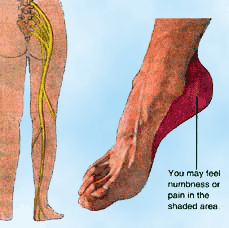 moves down the leg. There is a condition where the nerve
becomes compressed as it passes under a muscle in the hip that
results in the nerve sending pain messages to the brain that
in many cases are phantom pains. Phantom pains from sciatica
will give the impression that the only place where pain is occurring
is in the heels of the feet and there is no pain in the knee
or lower leg area. Sciatica is associated with a feeling
of numbness in the heel and may be associated with a burning
pain at night. Getting treatment for the Sciatica in many
cases is the cure for the heel pain. Sometimes a herniated
disk is the cause of the heel pain but usually there is back
pain and muscle spasms from the disk pressing on the root that
is exiting the spine. Sciatica in many cases is successfully
treated with anti-inflammatory medications such as Celebrex and
physical therapy including manipulation of the back and the Illiopsoas
muscle that is usually the muscle that is compressing the Sciatic
nerve. Prior to any physical therapy, evaluation is essential
to insure that the herniation of the disk will not increase with
physical therapy.
moves down the leg. There is a condition where the nerve
becomes compressed as it passes under a muscle in the hip that
results in the nerve sending pain messages to the brain that
in many cases are phantom pains. Phantom pains from sciatica
will give the impression that the only place where pain is occurring
is in the heels of the feet and there is no pain in the knee
or lower leg area. Sciatica is associated with a feeling
of numbness in the heel and may be associated with a burning
pain at night. Getting treatment for the Sciatica in many
cases is the cure for the heel pain. Sometimes a herniated
disk is the cause of the heel pain but usually there is back
pain and muscle spasms from the disk pressing on the root that
is exiting the spine. Sciatica in many cases is successfully
treated with anti-inflammatory medications such as Celebrex and
physical therapy including manipulation of the back and the Illiopsoas
muscle that is usually the muscle that is compressing the Sciatic
nerve. Prior to any physical therapy, evaluation is essential
to insure that the herniation of the disk will not increase with
physical therapy.
TARSAL TUNNEL SYNDROME
Tarsal
Tunnel Syndrome is a rare condition in the ankle that is commonly
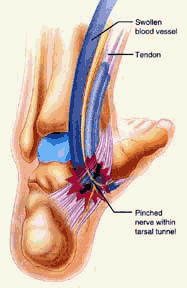 misdiagnosed because
the symptoms can mimic different conditions in the foot. The
nerve that is being compressed in the tarsal tunnel innervates
the entire bottom of the foot and all of the muscles in the bottom
of the foot. Because the Posterior Tibial Nerve is such
an important nerve and because it innervates most of the foot,
when the nerve becomes injured from excessive pressure in the
tarsal tunnel, the nerve can give off many different types of
pains. The key to making the correct diagnosis is obtaining
a good history of the patient and having the experience to suspect
that the tarsal tunnel is the problem to the patient's pain.
Tarsal tunnel syndrome is usually associated with a radiation
of pain either up or down the leg or foot. Diagnosis is
based on clinical judgment and performing a local anesthetic
block to determine if all of the pain is resolved with numbing
of the tarsal tunnel. Nerve conduction studies are performed
but only are positive after the Posterior Tibial Nerve has lost
half of its function. Diagnosis of Tarsal Tunnel Syndrome
should be made prior to and not after the nerve has lost half
of its function.
misdiagnosed because
the symptoms can mimic different conditions in the foot. The
nerve that is being compressed in the tarsal tunnel innervates
the entire bottom of the foot and all of the muscles in the bottom
of the foot. Because the Posterior Tibial Nerve is such
an important nerve and because it innervates most of the foot,
when the nerve becomes injured from excessive pressure in the
tarsal tunnel, the nerve can give off many different types of
pains. The key to making the correct diagnosis is obtaining
a good history of the patient and having the experience to suspect
that the tarsal tunnel is the problem to the patient's pain.
Tarsal tunnel syndrome is usually associated with a radiation
of pain either up or down the leg or foot. Diagnosis is
based on clinical judgment and performing a local anesthetic
block to determine if all of the pain is resolved with numbing
of the tarsal tunnel. Nerve conduction studies are performed
but only are positive after the Posterior Tibial Nerve has lost
half of its function. Diagnosis of Tarsal Tunnel Syndrome
should be made prior to and not after the nerve has lost half
of its function.
Treatment for Tarsal Tunnel Syndrome consists of resting the nerve by either using a night splint or a cast for a month. In addition, cortisone injection therapy, anti-inflammatory medicines and physical therapy can all be used singularly or in combination. When the pain is severe and treatment is failing, it is the judgment of the patient and the doctor to go forth with decompression surgery. The surgery involves releasing the strong fascia sheets overlying the nerve and carefully freeing up the nerve along the entire distance where the Posterior Tibial Nerve moves from the back of the ankle to the bottom of the foot. Depending on how the nerve is entrapped, the surgeon will determine how extensive of a decompression is required. The prognosis after surgery is excellent with typically a couple of months will be required to allow the nerve to heal completely.
Home -- About Us -- Services - Podiatry Topic Library -- Useful Podiatry Links -- New Patient Forms
Podiatrist Information on Foot Pain Topics including: Bunion Surgery Plantar Fasciitis Heel Pain Neuropathy Foot Orthotic Hammertoes Ingrown Toenail Neuroma Pain Running Injuries Wound Care Ankle Sprains Warts Fungus Toenails
Arthritic Foot Conditions Athlete's Foot Pediatric Growth Plate Pain Geriatric Foot Problems
Foot and Ankle Fractures Diabetic Foot Problems Callouses Metatarsal Stress Fracture
Offering Podiatric Surgery, Foot Surgery, Wound Care, Sports Medicine and Foot Orthotics,
Foot and Ankle Surgery and other treatments for Foot and Ankle Pain and Injuries.
Podiatry
and Foot related diagnostics and procedures are performed in Placentia / Yorba LInda, CA.
Podiatrists
Dr. Mark Reed and Dr. Melanie Reed
Placentia Linda Foot Ankle Group Podiatry Associates
Office of Mark Reed, DPM: 1275 N. Rose Drive, Suite 136 | Placentia, CA 92870 | Tel: 714-528-FOOT
Office of Melanie Reed, DPM: 1275 Rose Drive | Suite 124 | Placentia | CA 92870 | Tel: 714-528-7777
Yorba Linda Satellite Office: 21580Yorba LInda Blvd | Yorba Linda, CA 92887
www.footpain.org
Serving Placentia, CA and the surrounding North Orange County cities of Yorba Linda (92886, 92887), Brea (92821, 92822, 92823), Anaheim (92807, 90808), & Fullerton 92831, 92832, 92833, 92834, 92835 92836), Tustin (92780, 92781, 92783), and Orange (92861 92862 92865 92866 92867 92868 92869)